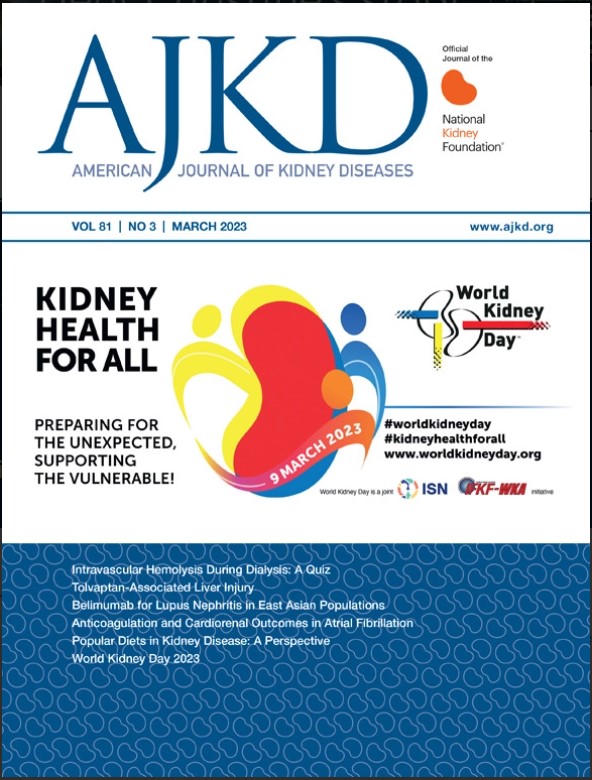Erythrocytosis and CKD: A Review
IF 9.4
1区 医学
Q1 UROLOGY & NEPHROLOGY
引用次数: 0
Abstract
Erythrocytosis or polycythemia is defined as an increase in red blood cell concentration above the age- and sex-specific normal levels. Unlike anemia, which is very common in patients with chronic kidney disease (CKD), erythrocytosis is less frequent but requires specific understanding by health care professionals in order to provide the best care. Erythrocytosis, especially when undiagnosed and untreated, can lead to serious thrombotic events and higher mortality. Classic causes of erythrocytosis associated with CKD include cystic kidney diseases, kidney or other erythropoietin-secreting neoplasms, high-altitude renal syndrome, overdosage of erythropoietin-stimulating agents, androgen therapy, heavy smoking, chronic lung disease, obstructive sleep apnea, IgA nephropathy, post–kidney transplant erythrocytosis, renal artery stenosis, and congenital etiologies. After ruling out the common acquired causes of erythrocytosis and/or in the presence of suggestive parameters, primary erythrocytosis or polycythemia vera (PV) should be considered, and patients should be screened for JAK2V617F somatic mutation. The newest entity inducing erythrocytosis is linked to the use of sodium/glucose cotransporter 2 (SGLT2) inhibitors that hypothetically activate hypoxia-inducible factor 2α (HIF-2α) and in some cases unmask PV. This Review focuses on the pathogenesis, renal manifestations and management of PV, the pathophysiology of erythrocytosis induced by SGLT2 inhibitors and the relevance of timely JAK2 mutation screening in these patients.
红细胞增多症和慢性肾脏病。
红细胞增多症或多血症是指红细胞浓度高于特定年龄和性别的正常水平。与慢性肾脏病(CKD)患者常见的贫血不同,红细胞增多症的发病率较低,但需要医护人员对其有具体的了解,以便提供最佳护理。红细胞增多症,尤其是在未经诊断和治疗的情况下,可导致严重的血栓事件和更高的死亡率。与慢性肾脏病相关的红细胞增多症的典型病因包括囊性肾病、肾脏或其他分泌促红细胞生成素的肿瘤、高海拔肾综合征、促红细胞生成素刺激剂用量过多、雄激素治疗、大量吸烟、慢性肺病、阻塞性睡眠呼吸暂停、IgA 肾病、肾移植后红细胞增多症、肾动脉狭窄和先天性病因。在排除红细胞增多症的常见获得性病因后,和/或出现提示性指标时,应考虑原发性红细胞增多症或真性多血症(PV),并对患者进行 JAK2V617F 体细胞突变筛查。诱发红细胞增多症的最新实体与钠-葡萄糖共转运体-2(SGLT2)抑制剂的使用有关,这种抑制剂可假定激活缺氧诱导因子 2-α(HIF-2α),并在某些情况下揭示出红细胞增多症。本综述将重点介绍红细胞增多症的发病机制、肾脏表现和治疗、SGLT2 抑制剂诱导的红细胞增多症的病理生理学以及对这些患者进行及时的 JAK2 基因突变筛查的意义。
本文章由计算机程序翻译,如有差异,请以英文原文为准。
求助全文
约1分钟内获得全文
求助全文
来源期刊

American Journal of Kidney Diseases
医学-泌尿学与肾脏学
CiteScore
20.40
自引率
2.30%
发文量
732
审稿时长
3-8 weeks
期刊介绍:
The American Journal of Kidney Diseases (AJKD), the National Kidney Foundation's official journal, is globally recognized for its leadership in clinical nephrology content. Monthly, AJKD publishes original investigations on kidney diseases, hypertension, dialysis therapies, and kidney transplantation. Rigorous peer-review, statistical scrutiny, and a structured format characterize the publication process. Each issue includes case reports unveiling new diseases and potential therapeutic strategies.
 求助内容:
求助内容: 应助结果提醒方式:
应助结果提醒方式:


